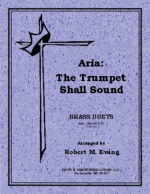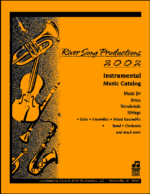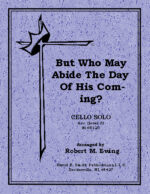-
March from “Scipione”
$29.95This march, from George Frideric Handel’s opera Scipione was composed in 1725 and received its first public performance a year later in England. The march appears in the last section of the opera’s overture and again at the start of the action. This is lively music from the late Baroque period and has often been rescored for solo instruments as well as large ensembles.
-
Hallelujah Chorus
$5.00A solo instrument with piano accompaniment? Can an arrangement capture the essence of the original with the majesty of full chorus and orchestra? This piece really does- it is amazingly complete!
-
Festive Brass
$60.002 Trumpets, 2- Trombones, organ with otional trombone and tuba with parts on a printable CD
-
-
The Trumpet Shall Sound- Aria
$6.50Taken from the “Messiah”, this duet (trpt. and tromb.-opt bar/tuba) with piano is essentially a transcription of the original work. The balance in the writing between the solo and the accompaniment allows for great flavor.
-
-
-
-
-
And the Glory of the Lord
$17.002 tpts, horn, tbn, tbn/tuba (tpt sub. for horn) MESSIAH FOR BRASS SERIES
-
-
Hallelujah Chorus
$60.00Choir I: Trp I in D, Trp II in D, Trp III in C, Alto Trom., Trb I, Trm II, Bass Trb., Tuba; Choir II: Trp I in Bb, Trp II in Bb, Trp III in Bb, Trom I, Trom II, Trom III, Tuba Hn I/II, Horn III/IV, Hn V/VI; Perc: Chimes I/II, Piatt-large; Organ; Substitues: Horn for Alto Trom, Bass doubles Tuba (Choir I), Bass doubles Tuba Choir II)
-
But Whom May Abide The Day…
$6.50Taken from the “Messiah”, this solo with piano is essentially a transcription of the original work. It features sufficient counterpoint between the various instruments.
-
Pastoral Symphony
$5.00An accompanied violin duet taken from Handel’s Messiah. After a two measure introduction the violins (in duet form) present the tune in simple form with occasional trills. It starts softly and builds climatically and progresses back to soft stages where it goes back to the beginning and jumps to a abbreviated coda.
-
Festival of Carols
$11.00Scored for 2 trumpets, horn, trombone, baritone and tuba this medley is a celebration of Christmas. Included are “Joy To The World,” “Angels We Have Heard On High,” “Silent Night,” and “O Come, All Ye Faithful.”
-
O Thou That Tellest G/Tid’gs
$13.00Taken from the “Messiah”, this brass quintet is essentially a transcription of the original work. It features sufficient counterpoint between the various instruments.
-
And He Shall Purify
$13.00Taken from the “Messiah”, this brass quintet is essentially a transcription of the original work. It features sufficient counterpoint between the various instruments.
-
And With His Stripes
$11.00Taken from the “Messiah”, this brass quintet is essentially a transcription of the original work. It features sufficient counterpoint between the various instruments.
-
But Whom May Abide The Day…
$4.00Taken from the “Messiah”, this solo with piano is essentially a transcription of the original work. It features sufficient counterpoint between the various instruments.
-
But Whom May Abide The Day…
$4.00Taken from the “Messiah”, this solo with piano is essentially a transcription of the original work. It features sufficient counterpoint between the various instruments.
-
Hallelujah Chorus
$5.00A solo instrument with piano accompaniment? Can an arrangement capture the essence of the original with the majesty of full chorus and orchestra? This piece really does- it is amazingly complete!
-
Fantasia on Joy To The World
$9.00Built for a trumpet quartet, it has an optional horn part if needed. The piece has many imitative devices giving it an antiphonal aura. It’s joy from beginning to end.
-
Rejoice Greatly Ye Daughters of Zion
$6.50Taken from the “Messiah”, this trumpet solo with piano is essentially a transcription of the original work. The balance in the writing between the solo and the accompaniment gives way to the sensitivity of the text of this well-know aria..
-
But Whom May Abide The Day…
$4.00Taken from the “Messiah”, this solo with piano is essentially a transcription of the original work. It features sufficient counterpoint between the various instruments.
-
Hallelujah Chorus
$5.00A solo instrument with piano accompaniment? Can an arrangement capture the essence of the original with the majesty of full chorus and orchestra? This piece really does- it is amazingly complete!


















